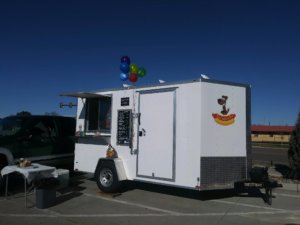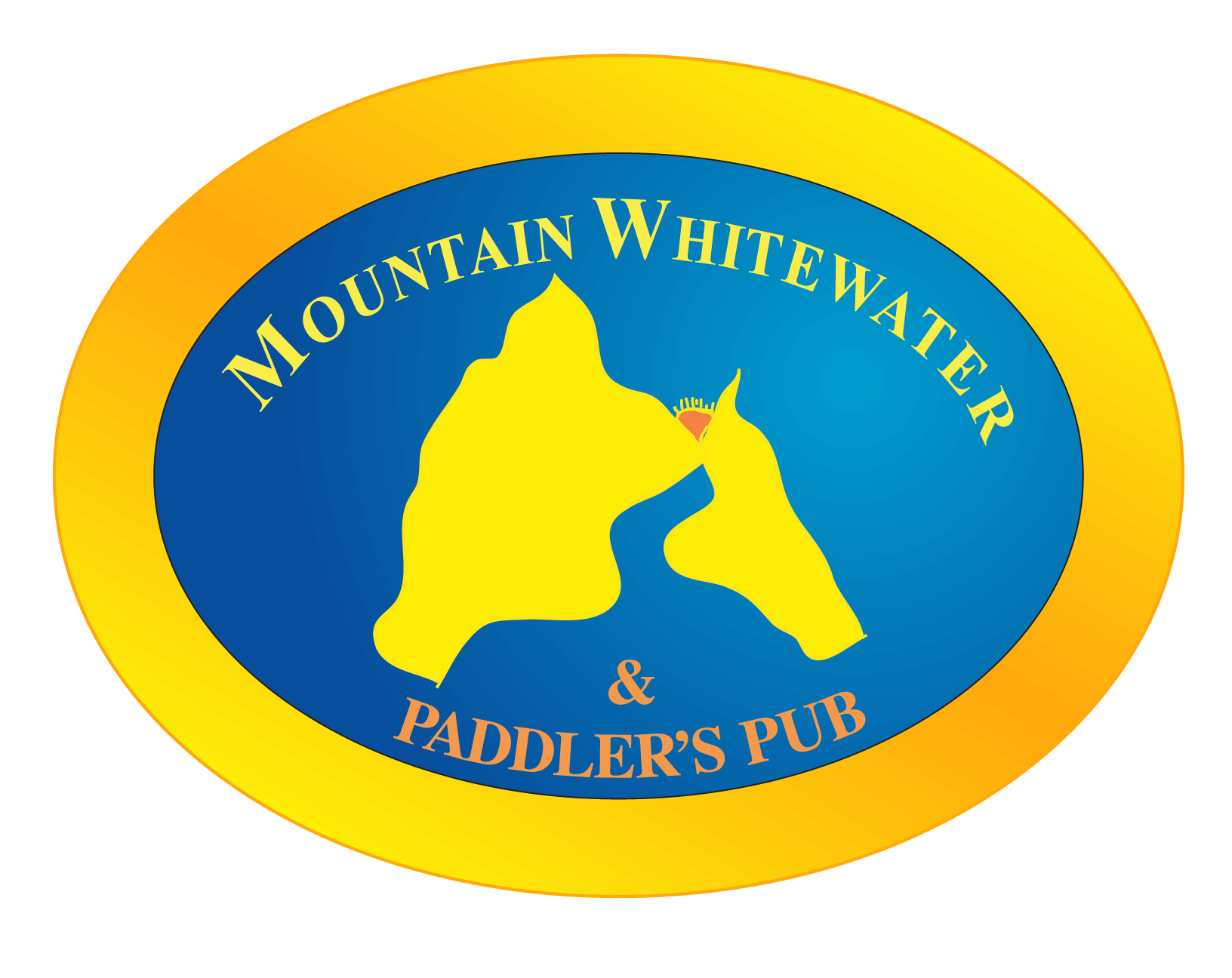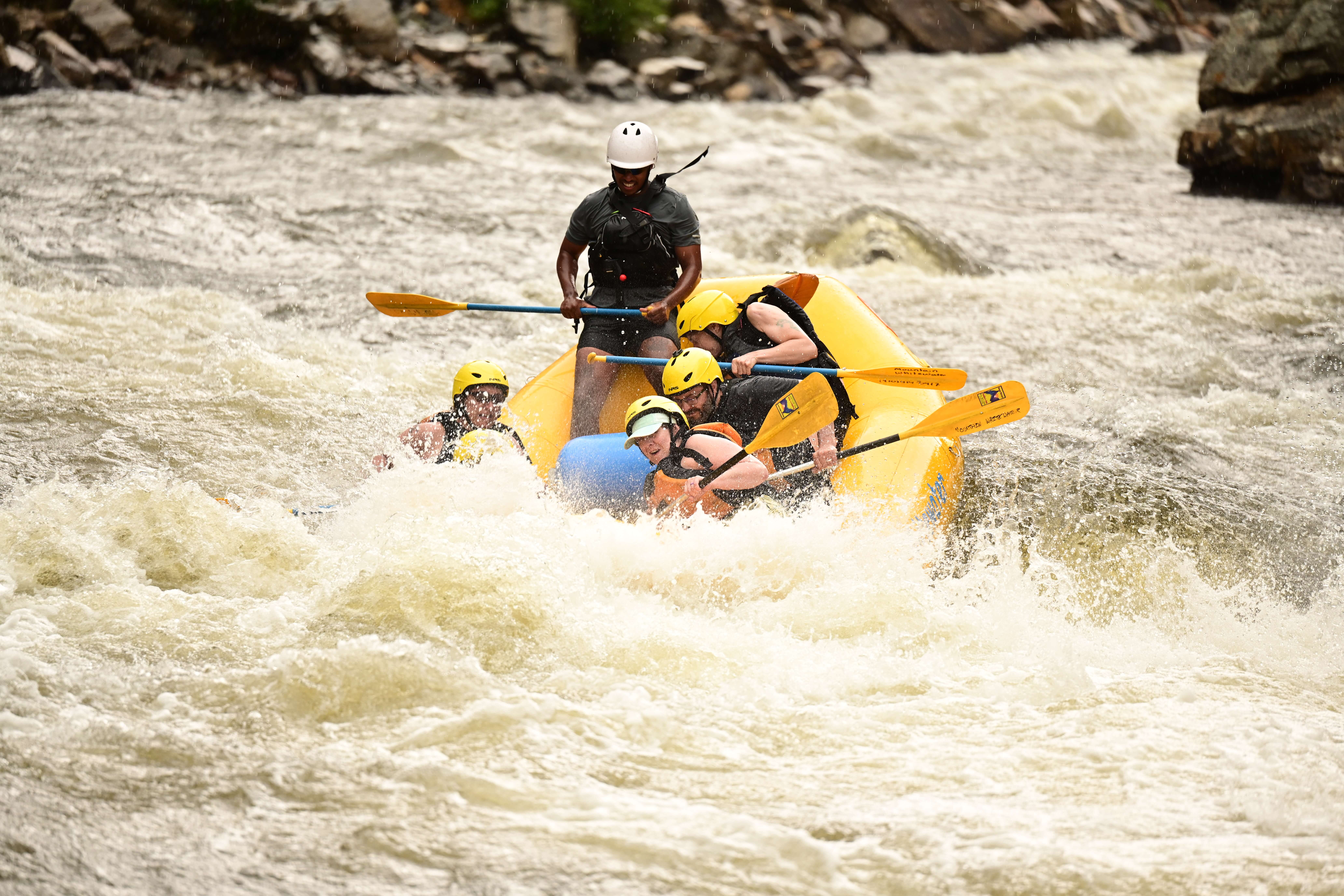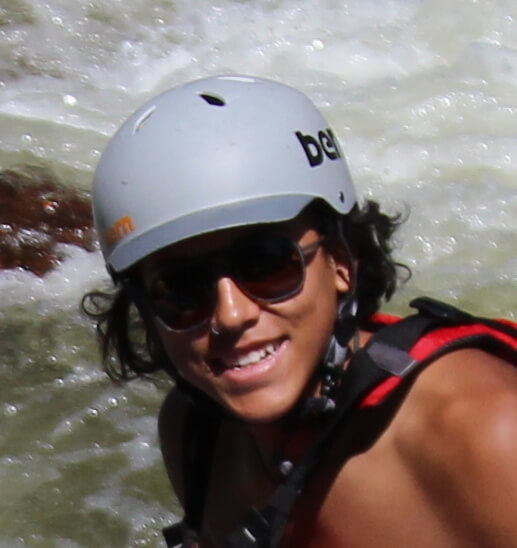Blog Posts
-
Raft Guide Training School 2024 | Mountain Whitewater

by Lindsey Modesitt, January 2024
Are you looking for a challenging, active, and rewarding career in the outdoors? If so, raft guide training school at Mountain Whitewater is perfect for you. Become a certified raft guide in the State of Colorado and earn the chance to be part of the Mountain Whitewater team by enrolling in our 2024 guide school.
Schedule & Materials
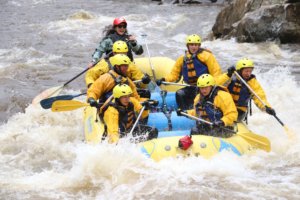 The course starts at 8:00 am on Monday, May 20th, 2024. The first week will consist of classroom sessions in the mornings. Classroom sessions will last until around noon, followed by on-river training in the afternoons (river level permitting). These classroom sessions will consist of a compilation of videos, slides, handouts, lectures, and quizzes. All dry-land instruction and classroom sessions take place on the grounds at Mountain Whitewater.
The course starts at 8:00 am on Monday, May 20th, 2024. The first week will consist of classroom sessions in the mornings. Classroom sessions will last until around noon, followed by on-river training in the afternoons (river level permitting). These classroom sessions will consist of a compilation of videos, slides, handouts, lectures, and quizzes. All dry-land instruction and classroom sessions take place on the grounds at Mountain Whitewater.Trainees will receive a training packet containing materials related to the course. The packets include all the required materials from the State of Colorado and Mountain Whitewater. The packets will serve as a guide throughout the course. Professionally Guiding Whitewater and The Complete Whitewater Rafter will be used as the main texts for the course and will be loaned to you for the duration of the course. Other books, videos, and other rafting-related materials are available to trainees through the Mountain Whitewater library.
The classroom sessions that are required by the State of Colorado to obtain your guide license are listed below. They will help visualize what is happening on the river and to understand why the boat acts a certain way in rapids. Classes are held early in the training process so that the skills learned in the classroom can be applied to the river.
- Monday, May 20th – 8 am: Paperwork, Employee Handbook, Equipment & Gear, Rigging
- Tuesday, May 21st – 9 am: River Currents, River Features, Paddle Commands, rating scales
- Wednesday, May 22nd – 9 am: Running the Rapids, Safety, Safety Talk, River Hazards
- Thursday, May 23rd – 9 am: River Rescue, Emergency Procedures, Rope Rescue
- Friday, May 24th – 9 am: Miscellaneous, Outdoor Impacts, How to be a Better Guide
Requirements
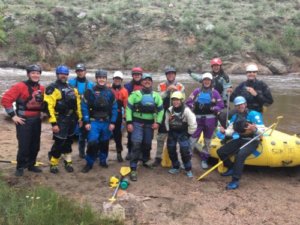
All trainees are required to meet the following criteria to become a raft guide at Mountain Whitewater.- Must be at least 18 years of age
- Must be able to attend all the above-listed class sessions
- Complete 100+ hours of on-river training required by Mountain Whitewater
- Must complete the Mountain Whitewater Rapid Check-off Sheet
- Must pass a basic First Aid and CPR class if not currently certified. Mountain Whitewater will host a class for staff and trainees sometime in the spring.
- Must complete the Mountain Whitewater Swiftwater Rescue class (included in training investment)
- Must pass a top to bottom check-out run with a trainer
- Treat the training course as if it were a very long job interview to show why you deserve to be part of the Mountain Whitewater team.
Instructors
There will be three main guide trainers; however, we will also have some of our returning guides help with training and instruction as well.
 Brad Modesitt (Owner), 24rd-year guide, Canyons Inc. River Rescue Course, Emergency Medical Technician-Basic (trained), Outdoor Emergency Care Technician, Wilderness First Responder. Brad Modesitt is from Michigan but has lived in Colorado most of his life. Privately he has boated on four continents while pursuing his passion of traveling. He has over 24,901 river miles which is the circumference of the earth! His favorite trip so far has been canoeing to New Orleans and then bicycling to Chile.
Brad Modesitt (Owner), 24rd-year guide, Canyons Inc. River Rescue Course, Emergency Medical Technician-Basic (trained), Outdoor Emergency Care Technician, Wilderness First Responder. Brad Modesitt is from Michigan but has lived in Colorado most of his life. Privately he has boated on four continents while pursuing his passion of traveling. He has over 24,901 river miles which is the circumference of the earth! His favorite trip so far has been canoeing to New Orleans and then bicycling to Chile.Justin “Baby J” Romero- Justin grew up in Fort Collins where he explores the mountains. Justin Graduated from Colorado State University in December with a degree in Forestry and Rangeland Management. He enjoys spending time in a hammock in the mountains and listening to the wind whip through the trees. When not on the river, Justin can be found eating burritos and listening to rock ‘n roll. He likes fishing, hunting, hiking snowboarding and many other things. He is trained in SwiftWater Rescue Techniques. This is Justin’s 5th year guiding on the Cache La Poudre
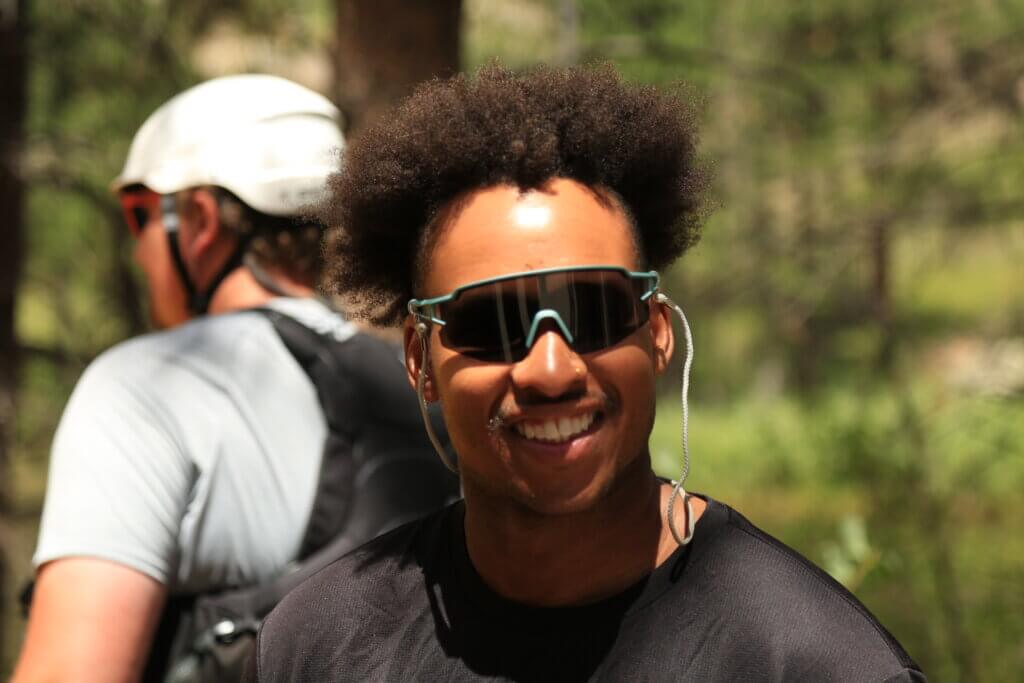 Evandel “Vano” Crabtree- Vano is from Dayton, Ohio where he grew up playing football and running track. He graduated from Sinclair College in Dayton, Ohio. Vano’s next adventure was to follow his heart and chase his passion for rafting. That passion found him in Fort Collins, Colorado. Vano’s love for rafting came from rafting trips as a kid in West Virginia. After discovering that guides were like superheroes, he decided that would be a perfect fit for him, we agreed. Vano is a SwiftWater trained and this is his 4th year as a guide on the Poudre River.
Evandel “Vano” Crabtree- Vano is from Dayton, Ohio where he grew up playing football and running track. He graduated from Sinclair College in Dayton, Ohio. Vano’s next adventure was to follow his heart and chase his passion for rafting. That passion found him in Fort Collins, Colorado. Vano’s love for rafting came from rafting trips as a kid in West Virginia. After discovering that guides were like superheroes, he decided that would be a perfect fit for him, we agreed. Vano is a SwiftWater trained and this is his 4th year as a guide on the Poudre River.Also assisting with Training for 2024
Matt Troyanek, Coe Stemple, Casey Batezel, Jack Reed, Melissa Matsunaka, Jacque “tiny” McVey, Casey Kramer
How to Apply
Training Investment: $395. Taking the class is not a guarantee of a job, but all new guides will be hired from the training class. If hired, half of the class fee is returned after the second full-time season working with Mountain Whitewater, the other half is returned after the third full-time season working with Mountain Whitewater. This cost covers the classroom sessions, dry-land sessions, equipment used during training (PFD, wetsuit, booties, splash jacket, and helmet), Swiftwater rescue class, and transportation to and from the Cache La Poudre River Canyon. Being a river guide is a multidimensional job requiring both physical skills and an outgoing personality. We are looking for people who can fulfill those needs. Ask around…we have the best-trained guides you will find.
If interested, contact us at contacts@raftmw.com or by calling 970-419-0917.
-
COVID-19 Announcement
Update June 9, 2020 We have always prided ourselves in the cleaning of our gear. Since opening in 2001, we have sanitized the gear daily, and we are taking additional measures to help with COVID-19 and protect you and our employees this season. Along with sanitizing PFDs, helmets, and wetsuits, we have also started sanitizing paddles between trips. We created a sanitation team, carrying backpack spray systems (think Ghost Busters, or Ghost Bleachers as we’ve been calling them) to take care of us all over the place. All employees are temperature and symptom checked daily. Guests are asked to stay home if they are symptomatic (fever, flu-like symptoms, cough, shortness of breath, etc.). The complimentary fleece jackets normally provided are very difficult for us to dry in time for the next needed trip, so this season we ask that you bring your own fleece jacket, which will get wet. Around the facilities, we’re also practicing extra precaution and following state and county guidelines. Our 12-acre site is mostly outdoors. Check-in for rafting is under a large tent with lots of ventilation. Bathrooms are scattered throughout the property, and are cleaned and sanitized often. The busses are running at 50% capacity with the windows down, even during inclement weather, to increase ventilation. The vehicles are sanitized after each trip. Boats will be limited to two households per boat. When you arrive at the Mountain Whitewater site:
- Masks are required when you enter, walk around and while on the bus, but not on the rafts. After your trip, you may sit in one of our 50 spaced out tables and enjoy a beer with your group without masks.
- Maintain social distancing from other groups by at least six feet.
- Fill and bring a reusable water bottle to share between your group while on the raft. Guides will attach personal water bottles to the raft using a caribiner clip, so check that your bottle has a loop or hook.
- Cleaning refers to the removal of germs, dirt, and impurities from surfaces. Cleaning does not kill germs, but by removing them, it lowers their numbers and the risk of spreading infection.
- Disinfecting refers to using chemicals to kill germs on surfaces. This process does not necessarily clean dirty surfaces or remove germs, but by killing germs on a surface after cleaning, it can further lower the risk of spreading infection.
- Cleaning and disinfection after persons suspected/confirmed to have COVID-19 have been in the facility
- It is recommended to close off areas used by the ill persons and wait as long as practical before beginning cleaning and disinfection to minimize potential for exposure to respiratory droplets. Open outside doors and windows to increase air circulation in the area. Restrict access for two hours after the sick person has left. If possible, wait up to 24 hours before beginning cleaning and disinfection.
- Clean and disinfect all areas (e.g., offices, bathrooms, and common areas) used by the ill persons, focusing especially on frequently touched surfaces. Continue to follow all cleaning and disinfecting recommendations provided below.
- Wear disposable gloves when cleaning and disinfecting surfaces. Gloves should be discarded after each cleaning. If reusable gloves are used, those gloves should be dedicated for cleaning and disinfection of surfaces for COVID-19 and should not be used for other purposes. Clean hands immediately after gloves are removed.
- If surfaces are dirty, they should be cleaned using a detergent or soap and water prior to disinfection.
- For disinfection, diluted household bleach solutions, alcohol solutions with at least 70% alcohol, and most common EPA-registered household disinfectants should be effective. Consult the manufacturer’s instructions for cleaning and disinfection products used.
- Diluted household bleach solutions can be used if appropriate for the surface. Check the label on the bleach container to be sure it provides claims about disinfecting and instructions for mixing. Follow manufacturer’s instructions for mixing, application and proper ventilation. Avoid using bottles of bleach that you think may be older than one year or are past their expiration date as marked on the bottle. Never mix household bleach with ammonia or any other cleanser. Unexpired household bleach will be effective against coronaviruses when properly diluted.
- Disinfect all “high-touch” surfaces in office desk area including computer keyboards, mouse, iPads, square stands, credit card readers, printers, copier, file cabinet handles, retail display handles once every two hours.
- Clean, then disinfect the following surfaces in the tent twice per day after each trip leaves: retail displays, office desk, photo station, bar, beer coolers, big table, canoe table, canoe pew, office and pub floors, water cooler, tent center poles.
- Disinfect all of the following areas in the office storage container twice per day: container handles, beer coolers, lockers, file cabinets, cash box, cash drawers.
- Make sure to wear disposable gloves when touching retail items when stocking and wash hand after.
- Make sure guests use hand sanitizer before shopping and touching any retail items and displays.
- Disinfect TV remotes twice per day.
- Clean, then disinfect the following surfaces in the main house twice per day after each trip leaves: door handles, bathroom surfaces, toilets, atm, brochure displays, light switches.
- Clean, then disinfect the following surfaces in the main house once per day: desk, floors, carpet.
- Make sure to wear disposable gloves and clean surfaces after using items or touching surfaces in the upstairs kitchen area. Bathroom surfaces in upstairs galley need to be sanitized once per day.
- All rental equipment must be disinfected after each return.
- Clean and disinfect all wrought iron tables, chairs, picknick tables, benches once per day.
- Hose off playground equipment once per day with soap and water once per day.
- Disinfect all stage and music equipment after use by bands.
- Hose-off all yard games once per day with disinfectant solution.
- Clean and disinfect gas grills, heaters, fire table once per day.
- Hose off all trash and recycle bins once per week with soap and water.
- Clean and disinfect tent walls once per week.
- Disinfect all “high-touch” surfaces in the bar area as often as possible, but at least once per hour: bar top, beer coolers, iPads, cash drawers, receipt printer, draft handles, water cooler, wine fridges, soda fridge, bar top games, beer lists.
- Clean and disinfect bar stools twice per shift.
- Clean and disinfect pub floor after each shift.
- Make sure to make a new bleach water solution to start each sift.
- Clean out inside of beer coolers and draft coolers twice per week.
- Make sure to disinfect tap locks and tap plugs before use on taps.
- Disinfect tavern heads once per shift.
- Disinfect handles and gauges on CO2 tanks once per shift.
- Clean and disinfect all rafting equipment after each use. Rafting equipment will not be re-used for another trip without being disinfected. All equipment must completely soak in disinfecting solution and Sink the Stink until saturated. Equipment must air dry for at least 20 minutes before being put away.
- Clean and disinfect the following surfaces in the boat barn once per day: helmet counter, changing room stall handles and hooks, door handles, electric pump blowers and cord, light switches.
- Sweep floor and vacuum floors every other day.
- Guides must make sure to wash hands or use hand sanitizer after cleaning gear and before each trip.
- Disinfect all bus seats door handles at the end of each day.
- Disinfect driver cab area after each day including steering wheel, seat, switches, air brake knob, and any other surface used that day.
- Sweep out bus floor after each day.
- Increase the frequency of cleaning and disinfecting our busses.
- Increase the frequency of cleaning and disinfecting of office and pub facilities.
- Post additional signage to encourage effective hand washing and hand sanitizer use to stop the spread of germs and viruses.
- Communitcate to our employees and guests the CDC guidelines for reducing the spread of germs and viruses.
-
The Laughing Dog Food Truck at Mountain Whitewater
By Ben Costello, January 2020
 We would like to introduce our friends The Laughing Dog Food Truck. Now OPEN FOR BUSINESS! Serving up all-beef hot dogs, the best chili cheese dogs ever, kraft dogs with spicy mustard, brats, hot polish sausages, their signature Diablo Sandwich and more. They always have a weekly rotating special and affordable pricing.
The Laughing Dog Food Truck will be available to feed the hungry guests at Mountain Whitewater & Paddler’s Pub every day during the 2020 rafting season. Nothing works up an appetite like an exciting whitewater rafting trip!
If you have questions or would like to book The Laughing Dog for an event, please call or email Kelly.
(970) 310-5590
kellykissell77@gmail.com
We would like to introduce our friends The Laughing Dog Food Truck. Now OPEN FOR BUSINESS! Serving up all-beef hot dogs, the best chili cheese dogs ever, kraft dogs with spicy mustard, brats, hot polish sausages, their signature Diablo Sandwich and more. They always have a weekly rotating special and affordable pricing.
The Laughing Dog Food Truck will be available to feed the hungry guests at Mountain Whitewater & Paddler’s Pub every day during the 2020 rafting season. Nothing works up an appetite like an exciting whitewater rafting trip!
If you have questions or would like to book The Laughing Dog for an event, please call or email Kelly.
(970) 310-5590
kellykissell77@gmail.com
